Did you know you can have a garden full of life all year? With the right tips, your garden can be a source of fresh produce and stunning flowers, no matter the season. To succeed, you need a plan, consistency, and the right tools. Follow these easy steps to make your garden bloom all year.
Key Takeaways
- Year-round gardening allows you to enjoy your garden throughout the year
- Seasonal planting tips are essential for a thriving garden
- Having a plan and being consistent are key for year-round gardening
- Using the right tools and techniques can extend the growing season
- Year-round gardening can include a variety of plants, such as cool-season crops and sun-loving flowers
- Organic gardening practices can help nurture plants and control pests
- Creating a year-round gardening schedule can help you stay on track and ensure a thriving garden
Understanding the Basics of Year-Round Gardening
To have a thriving garden, knowing the basics of year-round gardening is key. You need a garden planning calendar to track what to plant and when. This calendar is vital for planning and keeping your garden in top shape.
For all-season gardening, knowing your climate zone is important. Different plants grow better in different climates. Understanding your zone helps pick the right plants for your area. Also, preparing your soil is critical for your plants’ growth.
- Creating a garden planning calendar to keep track of planting and harvesting schedules
- Understanding your climate zone and selecting plants that thrive in your area
- Preparing your soil to provide nutrients for your plants
By following these basics, you can create a garden that blooms with flowers and yields tasty fruits and veggies all year.
| Season | Planting Schedule | Harvesting Schedule |
|---|---|---|
| Spring | February-May | May-July |
| Summer | June-August | July-September |
| Fall | September-November | November-January |
Spring Planting Strategies for Garden Success
Spring is the perfect time to plant flowers and vegetables like tomatoes, peppers, and cucumbers. To make your garden thrive, follow seasonal planting tips and keep up with garden maintenance. Water deeply but not too often to help roots grow strong.
When fertilizing, always follow the package instructions to avoid harming your plants. Sustainable gardening tips suggest using organic mulches like wood chips or shredded leaves. These mulches keep the soil moist and fight weeds, adding nutrients as they break down.
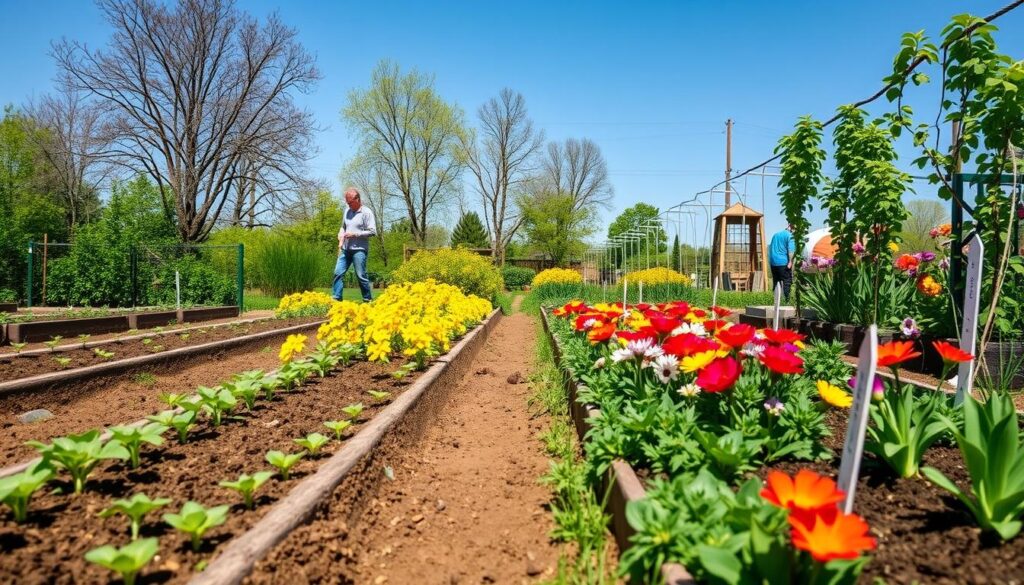
Succession planting is a great strategy for a continuous harvest. Plant vegetables and flowers every two weeks. Pairing cool-weather crops like lettuce with radishes saves space and lets you harvest early.
By using these seasonal planting tips and maintaining your garden well, you’ll have a lush and sustainable garden. Harvest your vegetables when they’re at their best for flavor and nutrition. Also, try companion planting, like basil with tomatoes, to improve taste and keep pests away.
Making the Most of Summer Growing Season
Summer is a great time to enjoy the fruits of your labor. Many plants are in full bloom and producing fruit. To make the most of summer, plant heat-resistant varieties like okra and southern peas. These thrive in the hot weather.
Proper seasonal garden maintenance is key. This includes regular watering and fertilization. It’s essential for a healthy garden.
For year-round harvesting, know the different growing seasons. Some plants, like tomatoes and peppers, love the warm weather. Others, like broccoli and kale, prefer cooler temperatures.
By choosing the right plants and caring for them, you can enjoy a bountiful harvest all year. This way, you can have a garden that’s always fruitful.
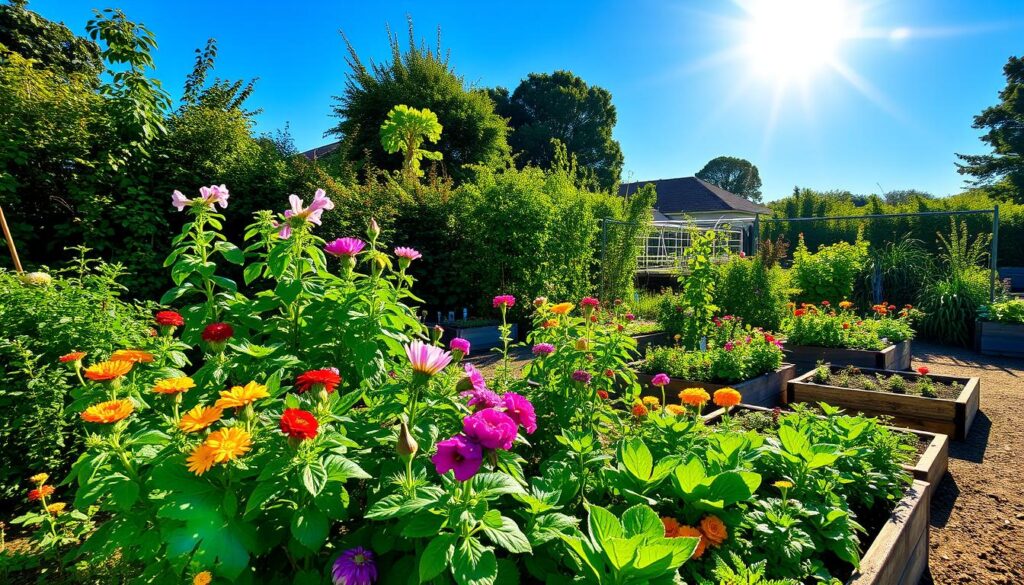
To keep your garden thriving in summer, use all-season gardening techniques. Deep and infrequent watering encourages deeper root growth. Mulching flower beds and vegetable patches helps retain soil moisture.
By following these tips and choosing the right plants, you can enjoy a successful year-round harvesting experience. Make the most of the summer growing season.
Heat-Resistant Plant Varieties
- Okra
- Southern peas
- Tomatoes
- Peppers
Watering Techniques for Hot Weather
Water your plants in the early morning or evening to avoid evaporation. Consider using a drip irrigation system. It delivers water directly to the roots.
Fall Garden Planning and Preparation
Fall is a great time to plan and prepare your garden for winter. As the weather cools, think about seasonal planting tips for a thriving garden. Plant cold-weather crops like broccoli and kale for their taste and nutrition.
Fall is also the time to get your garden ready for winter. Add mulch or compost to protect the soil and feed your plants. It’s also a good time to plant trees and shrubs, as the soil is warm enough for root growth. For a strong start in spring, plant perennials like hostas and sedum.
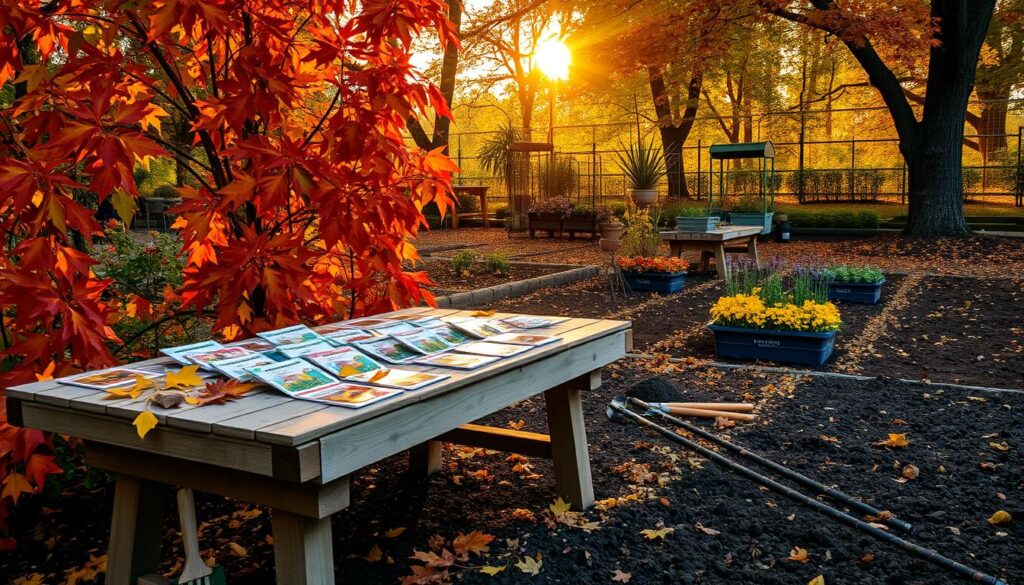
- Plant cold-weather crops like broccoli, kale, and spinach
- Prepare your beds for winter by adding a layer of mulch or compost
- Plant trees and shrubs to allow for root establishment
- Consider planting perennials like hostas, daylilies, and sedum
By using these sustainable gardening tips and garden maintenance strategies, you can have a garden that lasts through winter and into spring. Always keep seasonal planting tips in mind for the best garden results.
| Plant | Planting Time | Benefits |
|---|---|---|
| Broccoli | 6-8 weeks before first frost | Rich in nutrients, delicious |
| Kale | 6-8 weeks before first frost | Rich in nutrients, delicious |
| Spinach | 4-6 weeks before first frost | Rich in nutrients, easy to grow |
Winter Gardening: Indoor and Outdoor Solutions
Year-round gardening is key to a thriving garden. It includes tips for each season. Winter gardening lets you enjoy your garden even when it’s cold. Use indoor containers and cold frames to grow plants all year.
Rick Stone, a seasoned gardener in Utah, grows produce year-round. He uses cold-weather gardening to extend the growing season by six weeks. Plant hardy veggies like carrots and spinach in March under row covers.
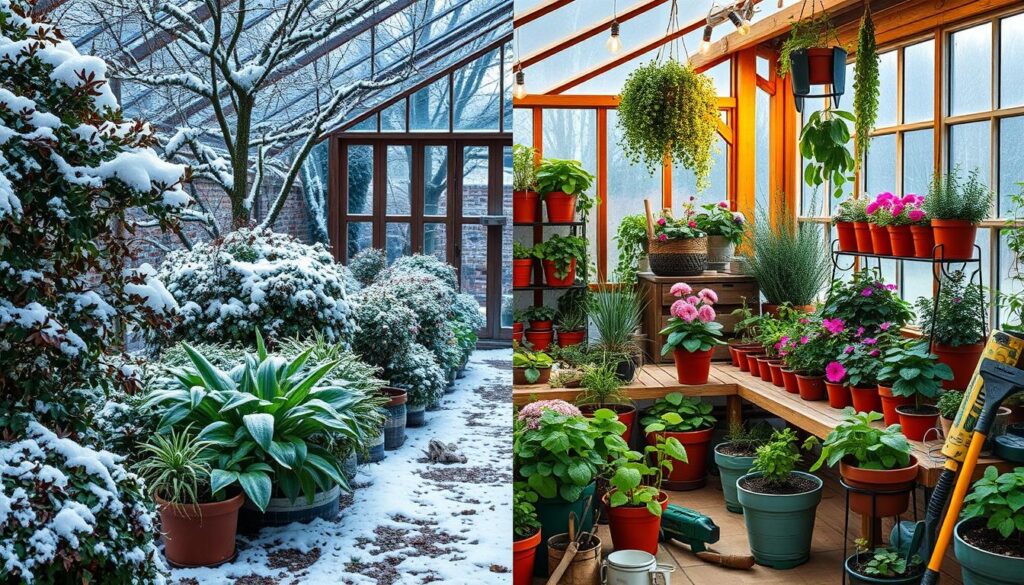
Choosing hardy plants is vital for winter gardening. Use mulch to protect roots. Cover plants during frosts. Some plants, like impatiens, can’t handle winter.
For indoor gardening, try windowsill gardens. They’re great for small spaces or cold climates. Quick-growing crops like arugula and spinach are perfect for indoor gardens. Follow these tips for a garden that thrives all year, even in winter.
Essential Tools and Equipment for Seasonal Planting
To have a thriving garden all year, you need the right tools and equipment. A garden planting calendar is key, helping you stay on track with planting. Gardening all year means being ready for every season, from snow blowers in winter to lawn mowers in summer.
Some must-have tools include a shovel, trowel, and pruning shears. You’ll also need season-specific gear like a snow blower or lawn mower. Keeping these tools in good shape is important. A tidy garden shed helps you find what you need easily.
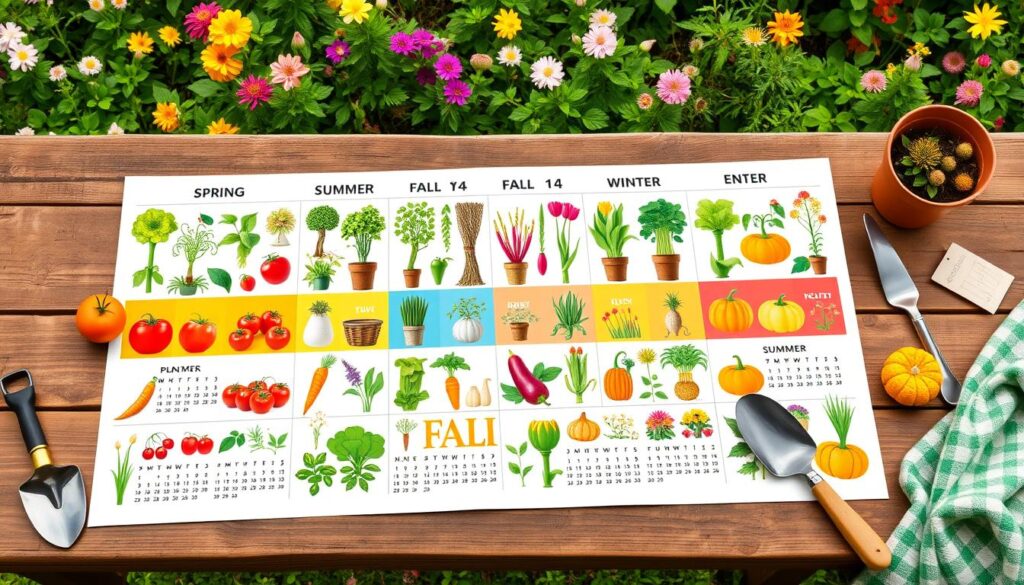
- Invest in a high-quality garden hose and watering can
- Use a garden cart or wheelbarrow to transport plants and soil
- Keep a set of gardening gloves and knee pads on hand
With the right tools, you’re set to create a garden that thrives all year. Always follow a garden planting calendar and use all-season gardening techniques for the best results.
| Tool | Purpose |
|---|---|
| Garden planting calendar | Keep track of planting schedules |
| Shovel | Digging and planting |
| Pruning shears | Pruning and trimming plants |
Sustainable Practices for a Year-Round Thriving Garden
Using sustainable gardening tips is key to a green and thriving garden. It’s vital to use compost and rainwater. These actions cut down on environmental harm and make the soil healthy.
Some essential sustainable gardening tips are:
- Using natural pest control methods, such as attracting beneficial insects and using physical barriers
- Implementing year-round harvesting techniques to maximize crop yields
- Practicing seasonal garden maintenance to ensure the garden remains healthy and productive throughout the year
By adopting these sustainable gardening tips, gardeners can make a garden that’s both stunning and eco-friendly. Also, using year-round harvesting and seasonal garden maintenance ensures a rich harvest and a strong garden ecosystem.
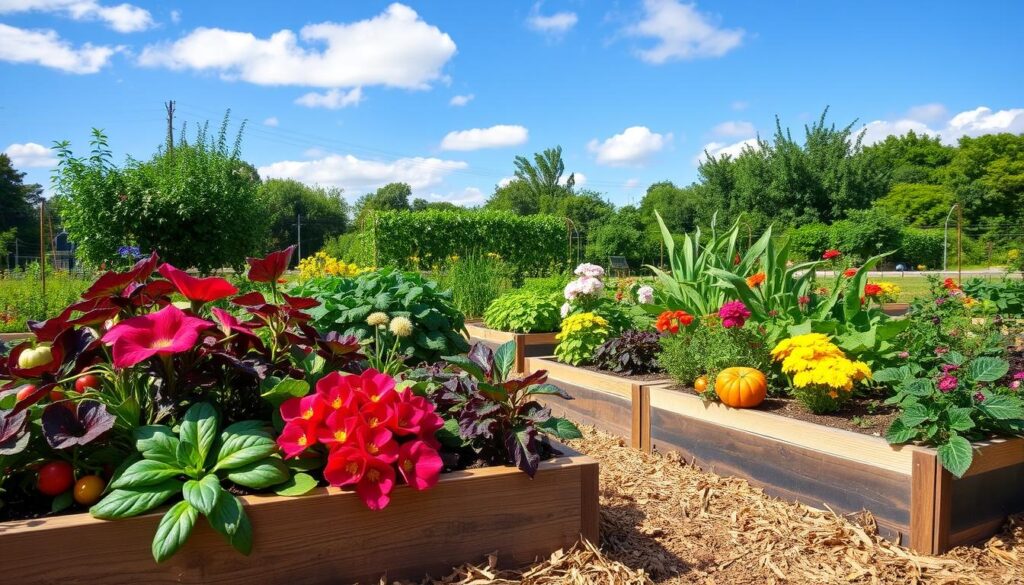
| Sustainable Gardening Practice | Benefits |
|---|---|
| Using Compost | Reduces waste, creates healthy soil ecosystem |
| Implementing Year-Round Harvesting | Maximizes crop yields, ensures consistent harvest |
| Practicing Seasonal Garden Maintenance | Ensures garden remains healthy and productive throughout the year |
Companion Planting Through the Seasons
Companion planting boosts your garden’s health and productivity. It attracts good bugs and keeps pests away. This method is key for sustainable gardening tips and works well with seasonal planting tips. It helps your garden thrive with less garden maintenance.
Some plants are great together, like marigolds and tomatoes. They keep nematodes away. Others, like basil and peppers, make your food taste better. Here are some good pairs:
- Basil with tomatoes to improve flavor
- Marigolds with tomatoes to repel nematodes
- Dill with cucumbers to attract beneficial insects
- Nasturtiums with kale, cabbage, and broccoli to repel aphids
Using companion planting in your seasonal planting tips makes a diverse garden. It needs less garden maintenance. This is a big part of sustainable gardening tips and helps your garden grow well.

| Companion Plant | Benefit |
|---|---|
| Marigolds | Repel nematodes |
| Basil | Improve flavor |
| Dill | Attract beneficial insects |
| Nasturtiums | Repel aphids |
Managing Garden Challenges Across Seasons
As a year-round gardener, you must be ready for each season’s challenges. Follow seasonal planting tips and keep your garden thriving. This way, you’ll have a great harvest and a beautiful outdoor space. It’s key to adapt to weather issues like drought and flooding, which can harm your garden.
To tackle garden challenges, diversify your plant selection with species that last all year. Create a garden maintenance schedule that covers autumn and winter. Also, optimize plant health with seasonal sunlight. For instance, move furniture to sunnier spots in summer and plants to shaded areas for better growth.
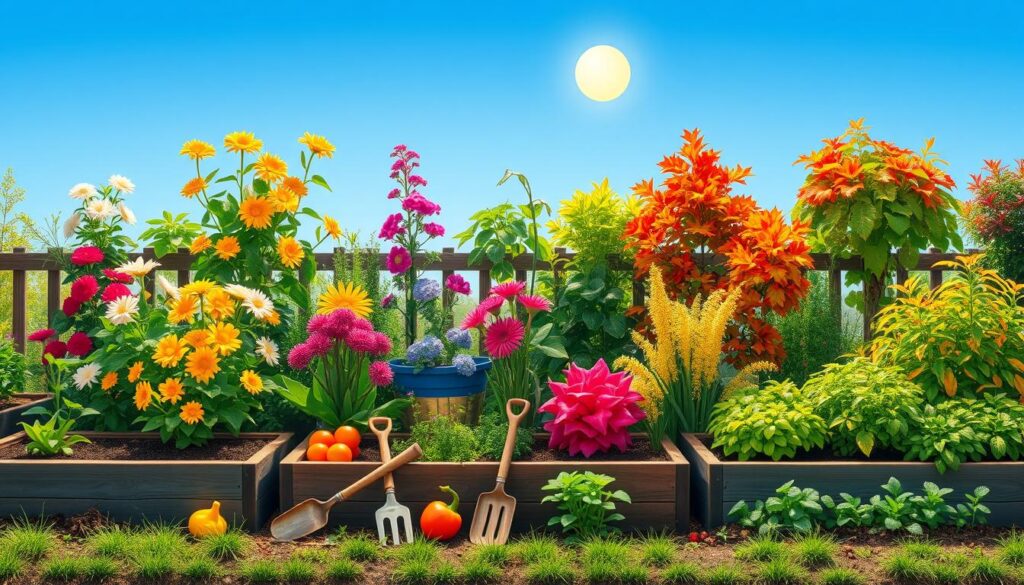
For a healthier garden, think about beekeeping to help with pollination. Use chicken fencing for pest control and to enrich the soil without harming plants. By being proactive in garden care and knowing the best practices for your climate, you can have a garden that thrives all year.
Weather-Related Issues
- Monitor weather forecasts to prepare for extreme weather conditions
- Use techniques such as mulching and irrigation to mitigate the effects of drought and flooding
- Plant species that are resistant to weather-related stress
Pest and Disease Control
Regularly check your plants for pests or disease. Act fast to stop infections from spreading. This includes introducing beneficial insects, organic pest control, and good garden hygiene.
Soil Management Solutions
Keep your soil healthy with organic matter like compost. Avoid chemical fertilizers. This supports your soil’s health and helps your garden thrive.
Conclusion: Creating Your Year-Round Garden Success Story
Creating a year-round garden needs hard work, careful planning, and flexibility. By using the tips from this article, you can make a garden full of life and color all year. It will give you plenty of fresh food and beautiful flowers.
Watch your plants closely and pick the best ones for your area. Try different ways of planting and improving the soil. Be open to new ideas and learning. This is how you grow a great garden.
With dedication and creativity, you can turn your outdoor space into a beautiful garden. Enjoy the journey of gardening all year. It’s a rewarding path to a healthy and beautiful garden.


